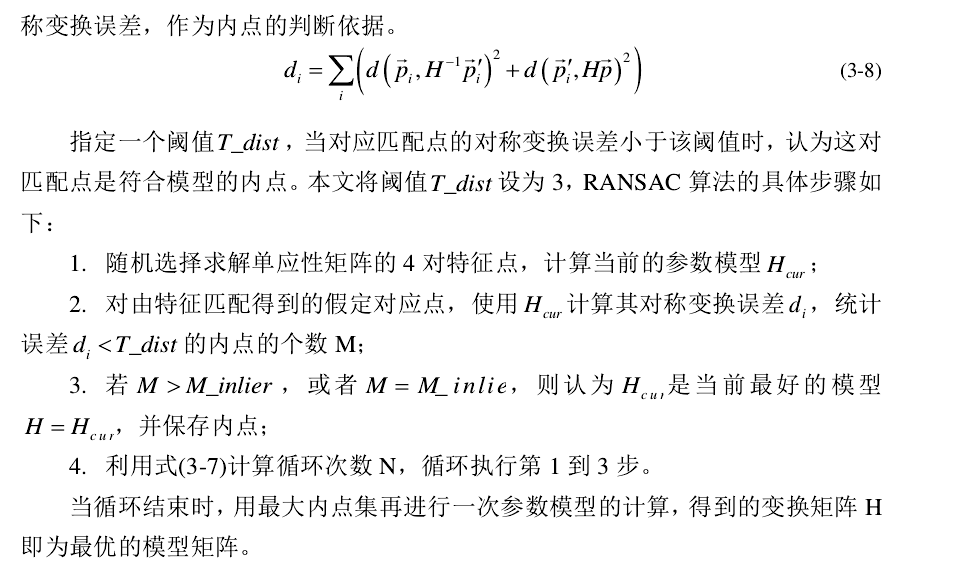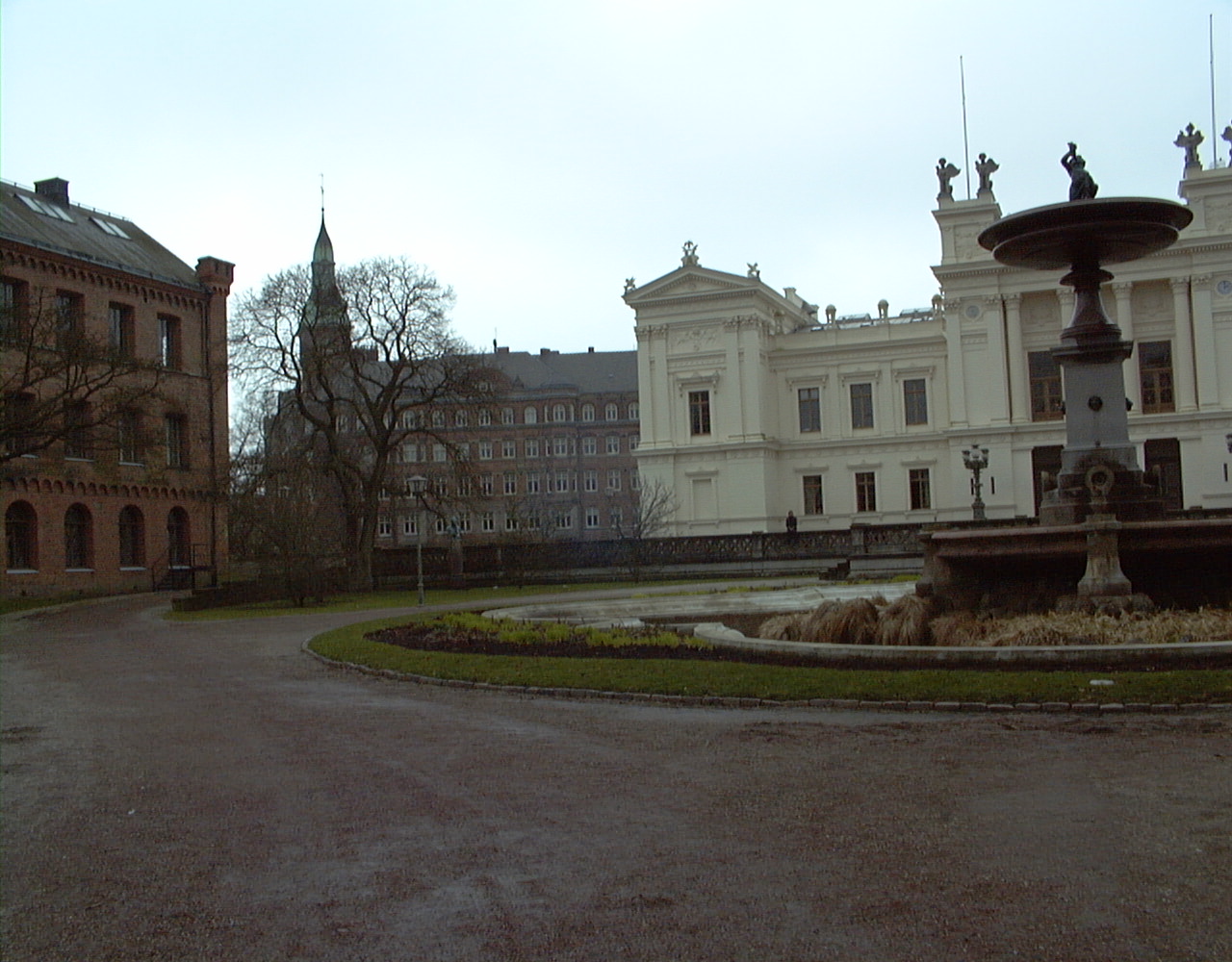RANSAC算法在图像拼接上的应用的实现
关于算法原理请参考《基于SURF特征的图像与视频拼接技术的研究》。






Mat H = findHomography( obj, scene, CV_RANSAC );
cv::Mat cv::findHomography( InputArray _points1, InputArray _points2,
int method, double ransacReprojThreshold, OutputArray _mask )
{
const double confidence = 0.995;
const int maxIters = 2000;
const double defaultRANSACReprojThreshold = 3;
bool result = false;
Mat points1 = _points1.getMat(), points2 = _points2.getMat();
Mat src, dst, H, tempMask;
int npoints = -1;
for( int i = 1; i <= 2; i++ )
{
Mat& p = i == 1 ? points1 : points2;
Mat& m = i == 1 ? src : dst;
npoints = p.checkVector(2, -1, false);
if( npoints < 0 )
{
npoints = p.checkVector(3, -1, false);
if( npoints < 0 )
CV_Error(Error::StsBadArg, "The input arrays should be 2D or 3D point sets");
if( npoints == 0 )
return Mat();
convertPointsFromHomogeneous(p, p);
}
p.reshape(2, npoints).convertTo(m, CV_32F);
}
CV_Assert( src.checkVector(2) == dst.checkVector(2) );
if( ransacReprojThreshold <= 0 )
ransacReprojThreshold = defaultRANSACReprojThreshold;
Ptr<PointSetRegistrator::Callback> cb = makePtr<HomographyEstimatorCallback>();
if( method == 0 || npoints == 4 )
{
tempMask = Mat::ones(npoints, 1, CV_8U);
result = cb->runKernel(src, dst, H) > 0;
}
else if( method == RANSAC )
result = createRANSACPointSetRegistrator(cb, 4, ransacReprojThreshold, confidence, maxIters)->run(src, dst, H, tempMask);
else if( method == LMEDS )
result = createLMeDSPointSetRegistrator(cb, 4, confidence, maxIters)->run(src, dst, H, tempMask);
else
CV_Error(Error::StsBadArg, "Unknown estimation method");
if( result && npoints > 4 )
{
compressPoints( src.ptr<Point2f>(), tempMask.ptr<uchar>(), 1, npoints );
npoints = compressPoints( dst.ptr<Point2f>(), tempMask.ptr<uchar>(), 1, npoints );
if( npoints > 0 )
{
Mat src1 = src.rowRange(0, npoints);
Mat dst1 = dst.rowRange(0, npoints);
src = src1;
dst = dst1;
if( method == RANSAC || method == LMEDS )
cb->runKernel( src, dst, H );
Mat H8(8, 1, CV_64F, H.ptr<double>());
createLMSolver(makePtr<HomographyRefineCallback>(src, dst), 10)->run(H8);
}
}
if( result )
{
if( _mask.needed() )
tempMask.copyTo(_mask);
}
else
H.release();
return H;
}
Ptr<PointSetRegistrator> createRANSACPointSetRegistrator(const Ptr<PointSetRegistrator::Callback>& _cb,
int _modelPoints, double _threshold,
double _confidence, int _maxIters)
{
CV_Assert( !RANSACPointSetRegistrator_info_auto.name().empty() );
return Ptr<PointSetRegistrator>(
new RANSACPointSetRegistrator(_cb, _modelPoints, _threshold, _confidence, _maxIters));
}
public:
RANSACPointSetRegistrator(const Ptr<PointSetRegistrator::Callback>& _cb=Ptr<PointSetRegistrator::Callback>(),
int _modelPoints=0, double _threshold=0, double _confidence=0.99, int _maxIters=1000)
: cb(_cb), modelPoints(_modelPoints), threshold(_threshold), confidence(_confidence), maxIters(_maxIters)
{
checkPartialSubsets = true;
}
int findInliers( const Mat& m1, const Mat& m2, const Mat& model, Mat& err, Mat& mask, double thresh ) const
{
cb->computeError( m1, m2, model, err );
mask.create(err.size(), CV_8U);
CV_Assert( err.isContinuous() && err.type() == CV_32F && mask.isContinuous() && mask.type() == CV_8U);
const float* errptr = err.ptr<float>();
uchar* maskptr = mask.ptr<uchar>();
float t = (float)(thresh*thresh);
int i, n = (int)err.total(), nz = 0;
for( i = 0; i < n; i++ )
{
int f = errptr[i] <= t;
maskptr[i] = (uchar)f;
nz += f;
}
return nz;
}
bool getSubset( const Mat& m1, const Mat& m2,
Mat& ms1, Mat& ms2, RNG& rng,
int maxAttempts=1000 ) const
{
cv::AutoBuffer<int> _idx(modelPoints);
int* idx = _idx;
int i = 0, j, k, iters = 0;
int esz1 = (int)m1.elemSize(), esz2 = (int)m2.elemSize();
int d1 = m1.channels() > 1 ? m1.channels() : m1.cols;
int d2 = m2.channels() > 1 ? m2.channels() : m2.cols;
int count = m1.checkVector(d1), count2 = m2.checkVector(d2);
const int *m1ptr = m1.ptr<int>(), *m2ptr = m2.ptr<int>();
ms1.create(modelPoints, 1, CV_MAKETYPE(m1.depth(), d1));
ms2.create(modelPoints, 1, CV_MAKETYPE(m2.depth(), d2));
int *ms1ptr = ms1.ptr<int>(), *ms2ptr = ms2.ptr<int>();
CV_Assert( count >= modelPoints && count == count2 );
CV_Assert( (esz1 % sizeof(int)) == 0 && (esz2 % sizeof(int)) == 0 );
esz1 /= sizeof(int);
esz2 /= sizeof(int);
for(; iters < maxAttempts; iters++)
{
for( i = 0; i < modelPoints && iters < maxAttempts; )
{
int idx_i = 0;
for(;;)
{
idx_i = idx[i] = rng.uniform(0, count);
for( j = 0; j < i; j++ )
if( idx_i == idx[j] )
break;
if( j == i )
break;
}
for( k = 0; k < esz1; k++ )
ms1ptr[i*esz1 + k] = m1ptr[idx_i*esz1 + k];
for( k = 0; k < esz2; k++ )
ms2ptr[i*esz2 + k] = m2ptr[idx_i*esz2 + k];
if( checkPartialSubsets && !cb->checkSubset( ms1, ms2, i+1 ))
{
iters++;
continue;
}
i++;
}
if( !checkPartialSubsets && i == modelPoints && !cb->checkSubset(ms1, ms2, i))
continue;
break;
}
return i == modelPoints && iters < maxAttempts;
}
bool run(InputArray _m1, InputArray _m2, OutputArray _model, OutputArray _mask) const
{
bool result = false;
Mat m1 = _m1.getMat(), m2 = _m2.getMat();
Mat err, mask, model, bestModel, ms1, ms2;
int iter, niters = MAX(maxIters, 1);
int d1 = m1.channels() > 1 ? m1.channels() : m1.cols;
int d2 = m2.channels() > 1 ? m2.channels() : m2.cols;
int count = m1.checkVector(d1), count2 = m2.checkVector(d2), maxGoodCount = 0;
RNG rng((uint64)-1);
CV_Assert( cb );
CV_Assert( confidence > 0 && confidence < 1 );
CV_Assert( count >= 0 && count2 == count );
if( count < modelPoints )
return false;
Mat bestMask0, bestMask;
if( _mask.needed() )
{
_mask.create(count, 1, CV_8U, -1, true);
bestMask0 = bestMask = _mask.getMat();
CV_Assert( (bestMask.cols == 1 || bestMask.rows == 1) && (int)bestMask.total() == count );
}
else
{
bestMask.create(count, 1, CV_8U);
bestMask0 = bestMask;
}
if( count == modelPoints )
{
if( cb->runKernel(m1, m2, bestModel) <= 0 )
return false;
bestModel.copyTo(_model);
bestMask.setTo(Scalar::all(1));
return true;
}
for( iter = 0; iter < niters; iter++ )
{
int i, goodCount, nmodels;
if( count > modelPoints )
{
bool found = getSubset( m1, m2, ms1, ms2, rng );
if( !found )
{
if( iter == 0 )
return false;
break;
}
}
nmodels = cb->runKernel( ms1, ms2, model );
if( nmodels <= 0 )
continue;
CV_Assert( model.rows % nmodels == 0 );
Size modelSize(model.cols, model.rows/nmodels);
for( i = 0; i < nmodels; i++ )
{
Mat model_i = model.rowRange( i*modelSize.height, (i+1)*modelSize.height );
goodCount = findInliers( m1, m2, model_i, err, mask, threshold );
if( goodCount > MAX(maxGoodCount, modelPoints-1) )
{
std::swap(mask, bestMask);
model_i.copyTo(bestModel);
maxGoodCount = goodCount;
niters = RANSACUpdateNumIters( confidence, (double)(count - goodCount)/count, modelPoints, niters );
}
}
}
if( maxGoodCount > 0 )
{
if( bestMask.data != bestMask0.data )
{
if( bestMask.size() == bestMask0.size() )
bestMask.copyTo(bestMask0);
else
transpose(bestMask, bestMask0);
}
bestModel.copyTo(_model);
result = true;
}
else
_model.release();
return result;
}
void setCallback(const Ptr<PointSetRegistrator::Callback>& _cb) { cb = _cb; }
AlgorithmInfo* info() const;
Ptr<PointSetRegistrator::Callback> cb;
int modelPoints;
bool checkPartialSubsets;
double threshold;
double confidence;
int maxIters;
};
RANSAC算法在图像拼接上的应用的实现的更多相关文章
- 理论沉淀:RANSAC算法
1.解决问题: 当一组样本数据中含有(较小波动的)正常数据(inliers)和(较大波动的)异常数据(outliers)且异常数据的量还不小于正常数据的量时,用最小二乘法将难以获得期望的直线(即能拟合 ...
- RANSAC算法详解
给定两个点p1与p2的坐标,确定这两点所构成的直线,要求对于输入的任意点p3,都可以判断它是否在该直线上.初中解析几何知识告诉我们,判断一个点在直线上,只需其与直线上任意两点点斜率都相同即可.实际操作 ...
- (转载)利用SIFT和RANSAC算法(openCV框架)实现物体的检测与定位,并求出变换矩阵(findFundamentalMat和findHomography的比较) 置顶
原文链接:https://blog.csdn.net/qq_25352981/article/details/46914837#commentsedit 本文目标是通过使用SIFT和RANSAC算法, ...
- 机器视觉之 ICP算法和RANSAC算法
临时研究了下机器视觉两个基本算法的算法原理 ,可能有理解错误的地方,希望发现了告诉我一下 主要是了解思想,就不写具体的计算公式之类的了 (一) ICP算法(Iterative Closest Poin ...
- 图像配准建立仿射变换模型并用RANSAC算法评估
当初选方向时就由于从小几何就不好.缺乏空间想像能力才没有选择摄影測量方向而是选择了GIS. 昨天同学找我帮他做图像匹配.这我哪里懂啊,无奈我是一个别人有求于我,总是不好意思开口拒绝的人.于是乎就看着他 ...
- OpenCV2马拉松第25圈——直线拟合与RANSAC算法
计算机视觉讨论群162501053 转载请注明:http://blog.csdn.net/abcd1992719g/article/details/28118095 收入囊中 最小二乘法(least ...
- 02-11 RANSAC算法线性回归(波斯顿房价预测)
目录 RANSAC算法线性回归(波斯顿房价预测) 一.RANSAC算法流程 二.导入模块 三.获取数据 四.训练模型 五.可视化 更新.更全的<机器学习>的更新网站,更有python.go ...
- RANSAC算法笔记
最近在做平面拟合,待处理的数据中有部分噪点需要去除,很多论文中提到可以使用Ransac方法来去除噪点. 之前在做图像配准时,用到了Ransac算法,但是没有去仔细研究,现在好好研究一番. 参考: ht ...
- 基于dsp_builder的算法在FPGA上的实现
基于dsp_builder的算法在FPGA上的实现 一.摘要 结合dsp_builder.matlab.modelsim和quartus ii等软件完成算法的FPGA实现. 二.实验平台 硬件平台 ...
随机推荐
- linux配置免密登录
例如: $ ssh -i ~/ec2.pem ubuntu@12.34.56.78 首先确定你可以以密码的形式连接远程服务器,也可以创建一个非超级管理员用户,并增加 sudo 权限. $ sudo s ...
- 【Select2】带搜索框的下拉框美化插件
1 引入js css 文件 <script src="js/jquery-1.11.1.min.js"></script> <script src= ...
- 【linux】Crontab 定时任务 使用实例
1 使用putty 登录linux 服务器 2 输入以下命令.查看已有的定时任务 crontab -l 3 输入 以下命令,进入定时任务文件 crontab -e 4 键盘 选择 i 键 进行输 ...
- Android Fingerprint系列之google原生界面
ENV: Anroid M 6.0 1. 录入指纹引导界面 2.指纹要求先设置密码或验证密码界面(已经添加安全密码) 3.引导用户寻找指纹传感器 4.录入指纹界面 5.指纹录入结束界面
- 报错 ERROR in static/js/vendor.b3f56e9e0cd56988d890.js from UglifyJs
开发vux项目在引入 // 表单验证组件-start import zh_CN from 'vee-validate/dist/locale/zh_CN' import Validator from ...
- sencha touch 入门系列 扩展篇之sencha touch 项目打包压缩
经常有新手同学抱怨说sencha touch的项目加载速度为什么这么慢,经常要10秒左右的时间甚至更多, 大家都知道,sencha touch开发的项目中引用了大量的js文件,当我们打开项目时,st的 ...
- web图片100%宽度自适应,高度不塌陷
一般在web端图片100%自适应,在页面加载的时候存在高度塌陷的问题 解决这个问题其实很简单,用padding-top设置百分比值来实现自适应,公式如下 padding-top = (Image He ...
- 【BZOJ2164】采矿 树链剖分+线段树维护DP
[BZOJ2164]采矿 Description 浩浩荡荡的cg大军发现了一座矿产资源极其丰富的城市,他们打算在这座城市实施新的采矿战略.这个城市可以看成一棵有n个节点的有根树,我们把每个节点用1到n ...
- 素数测试算法(基于Miller-Rabin的MC算法) // Fermat素数测试法
在以往判断一个数n是不是素数时,我们都是采用i从2到sqrt(n)能否整除n.如果能整除,则n是合数;否则是素数.但是该算法的时间复杂度为O(sqrt(n)),当n较大时,时间性能很差,特别是在网络安 ...
- 一步步从Spring Framework装配掌握SpringBoot自动装配
目录 Spring Framework模式注解 Spring Framework@Enable模块装配 Spring Framework条件装配 SpringBoot 自动装配 本章总结 Spring ...
